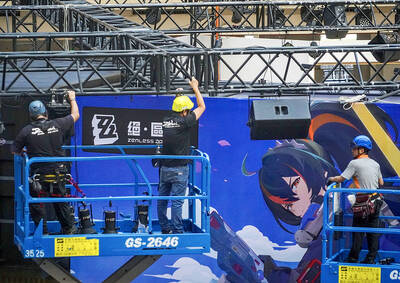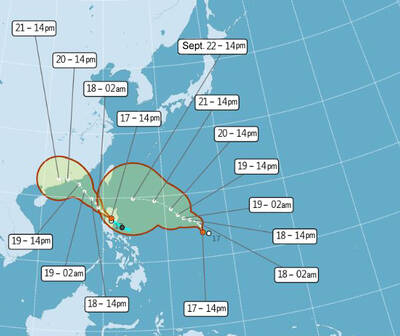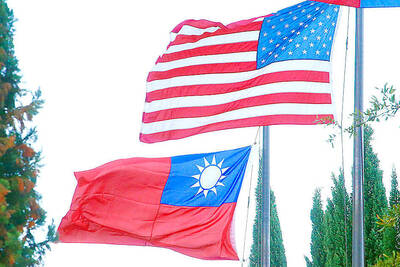Japan yesterday adopted a new five-year ocean policy that calls for stronger maritime security, including bolstering its coast guard’s capability and cooperation with the military amid China’s increasing assertiveness in regional seas.
The new Basic Plan on Ocean Policy, adopted by Japanese Prime Minister Fumio Kishida’s Cabinet, also says that Japan must accelerate the development of autonomous underwater vehicles and remotely operated robots to bolster its surveillance capability.
It cited a list of threats: The Chinese Coast Guard’s repeated intrusions into Japanese territorial waters, growing unauthorized maritime activity by “foreign survey boats” inside Japan’s exclusive economic zone, increasing joint military exercises by China and Russia, and North Korea’s repeated missile launches.

Photo: AP
“The situation in the ocean around Japan is increasingly tense,” Kishida said at a policy meeting yesterday. “It’s time for us to unite our wisdom among the industry, academia and government for ocean policy reform.”
He also noted the need to better use maritime resources to achieve carbon neutrality.
The new ocean policy is in line with Japan’s new national security strategy, which Kishida’s government adopted in December last year in a major break from its self-defense-only principle that the country has maintained under a pacifist constitution since World War II.
The new strategy highlights bolstering Japan’s military power with strike capability and doubling its defense budget within five years. The strategy also calls for closer cooperation between the military and the coast guard in any emergency over Taiwan or other possible conflicts.
The plan also said the capability of Japan’s coast guard, which has been on the front line of border disputes, needs to be improved. It frequently confronts Chinese Coast Guard vessels approaching disputed Japanese-controlled islands in the East China Sea, North Korean poachers and suspected spy boats, and Russian Coast Guard vessels near disputed northern islands.
The Japanese Coast Guard is used for civilian policing at sea and not military combat, and the new plans calling for closer cooperation with the Japanese Self-Defense Forces have raised concerns about its role and safety in a possible conflict.
The ocean plan also says Japan needs to be more aggressive about undersea surveys and using undersea resources for energy, calling for greater use of the exclusive economic zone outside of territorial waters to build offshore wind-power generators.
Japan has repeatedly protested over Chinese research ships entering its waters or the exclusive economic zone close to its boundary for apparent surveys of undersea deposits and other marine resources.

Taiwan is projected to lose a working-age population of about 6.67 million people in two waves of retirement in the coming years, as the nation confronts accelerating demographic decline and a shortage of younger workers to take their place, the Ministry of the Interior said. Taiwan experienced its largest baby boom between 1958 and 1966, when the population grew by 3.78 million, followed by a second surge of 2.89 million between 1976 and 1982, ministry data showed. In 2023, the first of those baby boom generations — those born in the late 1950s and early 1960s — began to enter retirement, triggering

ECONOMIC BOOST: Should the more than 23 million people eligible for the NT$10,000 handouts spend them the same way as in 2023, GDP could rise 0.5 percent, an official said Universal cash handouts of NT$10,000 (US$330) are to be disbursed late next month at the earliest — including to permanent residents and foreign residents married to Taiwanese — pending legislative approval, the Ministry of Finance said yesterday. The Executive Yuan yesterday approved the Special Act for Strengthening Economic, Social and National Security Resilience in Response to International Circumstances (因應國際情勢強化經濟社會及民生國安韌性特別條例). The NT$550 billion special budget includes NT$236 billion for the cash handouts, plus an additional NT$20 billion set aside as reserve funds, expected to be used to support industries. Handouts might begin one month after the bill is promulgated and would be completed within

One of two tropical depressions that formed off Taiwan yesterday morning could turn into a moderate typhoon by the weekend, the Central Weather Administration (CWA) said yesterday. Tropical Depression No. 21 formed at 8am about 1,850km off the southeast coast, CWA forecaster Lee Meng-hsuan (李孟軒) said. The weather system is expected to move northwest as it builds momentum, possibly intensifying this weekend into a typhoon, which would be called Mitag, Lee said. The radius of the storm is expected to reach almost 200km, she said. It is forecast to approach the southeast of Taiwan on Monday next week and pass through the Bashi Channel

NO CHANGE: The TRA makes clear that the US does not consider the status of Taiwan to have been determined by WWII-era documents, a former AIT deputy director said The American Institute in Taiwan’s (AIT) comments that World War-II era documents do not determine Taiwan’s political status accurately conveyed the US’ stance, the US Department of State said. An AIT spokesperson on Saturday said that a Chinese official mischaracterized World War II-era documents as stating that Taiwan was ceded to the China. The remarks from the US’ de facto embassy in Taiwan drew criticism from the Ma Ying-jeou Foundation, whose director said the comments put Taiwan in danger. The Chinese-language United Daily News yesterday reported that a US State Department spokesperson confirmed the AIT’s position. They added that the US would continue to